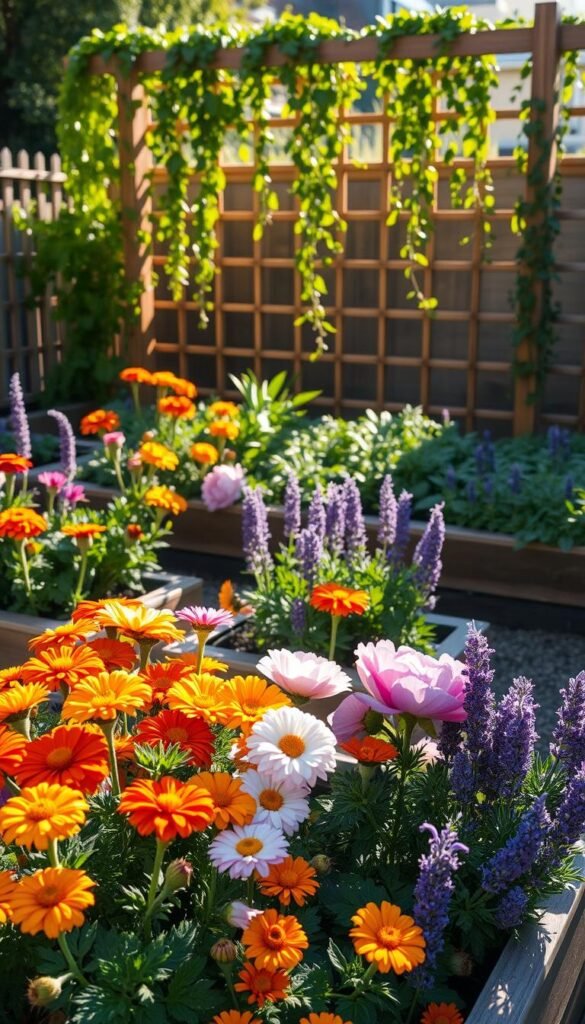Ever wondered how some gardeners grow vibrant blooms with half the effort? There’s a secret many enthusiasts swear by: elevated growing spaces. These setups transform how you nurture your favorite blossoms, offering advantages that feel almost magical compared to old-school methods.
Imagine tending to your favorite varieties without constant bending or battling poor soil. That’s the reality these systems create. You’ll directly influence what your greenery absorbs, from nutrient-rich mixes to perfect drainage. No more guessing games with compacted earth or unpredictable pH levels.
Accessibility takes center stage here. Whether you’re managing physical limitations or simply want a cleaner workspace, raised setups put everything at arm’s reach. Spacing becomes simpler, weeds stay manageable, and pests face tougher barriers. It’s like giving your blossoms a VIP section tailored just for them.
Seasoned growers often describe the shift as revolutionary—like upgrading from a flip phone to a smartphone. Your efforts yield more abundant blooms and stronger root systems, all while reducing back strain. Even beginners find success faster, thanks to the controlled environment.
Ready to explore how these innovative growing spaces can redefine your outdoor oasis? Let’s uncover why they’ve become the go-to solution for thriving, low-effort cultivation.
Discover the Benefits of Raised Bed Gardening
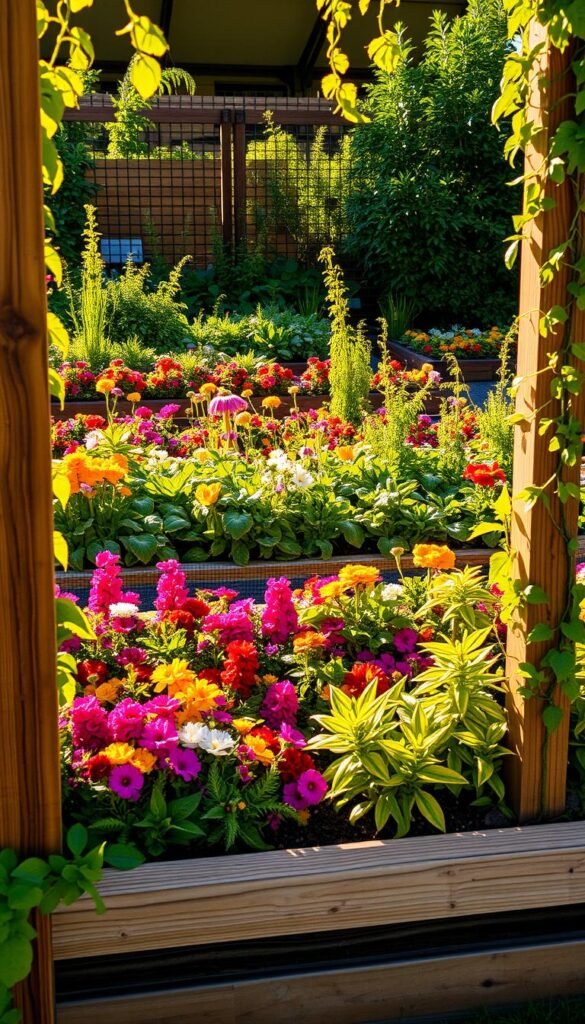
What if your outdoor space could combine beauty with practical growing solutions? Structured plots offer more than just organized layouts—they create opportunities for customization that ground-level planting can’t match.
Design Flexibility That Impresses
These contained growing areas turn chaotic patches into eye-catching displays. Neat edges and defined shapes help you craft designs that look straight from landscaping magazines. Stone borders or cascading blooms along the edges add professional polish even first-time growers can achieve.
Communities with strict appearance rules often approve these tidy setups. You’ll avoid disputes with landlords while creating spaces that neighbors admire. The contained nature prevents plants from sprawling where they shouldn’t.
Tailored Earth and Moisture Mastery
Struggling with dense clay or sandy earth? You get to handpick your growing medium. Mix in compost, peat moss, and perlite to create the perfect blend for your blossoms. This control helps prevent root rot and nutrient deficiencies.
Water management becomes simpler too. Elevated setups drain excess moisture 30% faster than traditional plots, according to recent horticulture studies. Pair them with drip lines or soaker hoses, and you’ll:
- Reduce water waste by 40-60%
- Prevent fungal diseases from overwatering
- Maintain consistent moisture levels
Raised Bed Flower Garden: Easier Maintenance and Healthier Plants
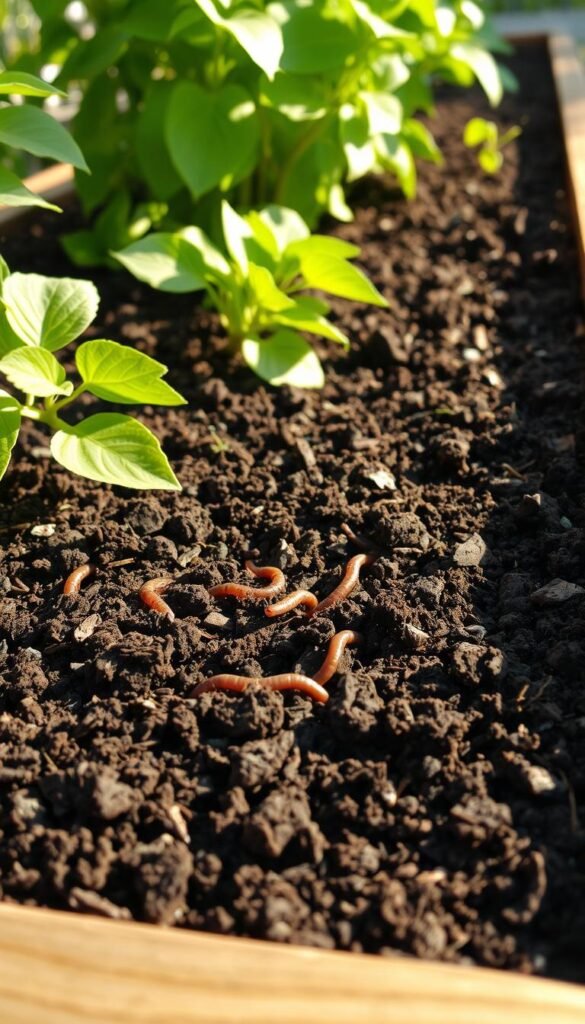
What if your garden could thrive with minimal effort on your part? The secret lies in how you structure your growing space. Contained plots create a nurturing environment where tasks feel simpler, and your blossoms flourish with intentional care.
Streamlined Upkeep and Nutrient Management
Rotating annuals between separate plots becomes effortless with multiple planting zones. This strategy disrupts pest life cycles and prevents soil depletion. You’ll notice fewer unwelcome visitors chewing on petals when you switch locations each season.
Refreshing earth quality takes minutes, not hours. Mix in a layer of compost like Black Gold’s organic blend to replenish micronutrients. Your greens get exactly what they need without guesswork—no more wrestling with unpredictable ground conditions.
Targeted care saves time and resources. Spot-treat issues in defined areas instead of wrestling with entire rows. Loose, aerated earth lets roots spread freely, resulting in sturdier stems and longer-lasting color displays. You’ll see up to 30% more blooms per plant compared to traditional methods.
These organized systems turn tedious chores into quick check-ins. Watering, pruning, and monitoring happen in focused bursts, leaving more time to enjoy your vibrant oasis.
Planning Your Raised Bed Garden Space

Smart layout decisions set the stage for success before you even lift a shovel. Where you position your growing area impacts everything from bloom quality to how often you’ll actually tend to it.
Selecting the Ideal Location: Sun, Water, and Accessibility
Sunlight acts like a growth accelerator for most blossoms. Aim for spots getting 6-8 hours of direct light daily. Observe your yard at different times—morning rays differ from harsh afternoon beams. Partial shade works for certain varieties, but full sun delivers the best results.
Keep your water source within 10-15 feet. You’ll thank yourself during summer dry spells when dragging hoses feels like a chore. Level ground prevents soil erosion and uneven watering. If your site slopes, consider terracing techniques from our step-by-step guide.
Designing a Layout That Fits Your Needs
Paths matter as much as planting zones. Leave 18-24 inches between beds for comfortable kneeling and wheelbarrow access. Place taller plants on north-facing edges to avoid shading shorter varieties.
Site prep is non-negotiable. Remove existing grass completely—roots left behind can regrow through your soil. Lay cardboard over cleared areas to smother any stubborn weeds. One gardener shared: “This barrier saved me hours of weeding later—best decision I made!”
Prioritize visibility from your kitchen or patio. When you see your blooms daily, you’ll catch issues early and harvest stems at peak freshness. Compact designs work wonders for urban spaces, while sprawling layouts suit country settings.
Designing an Attractive Raised Bed Flower Garden
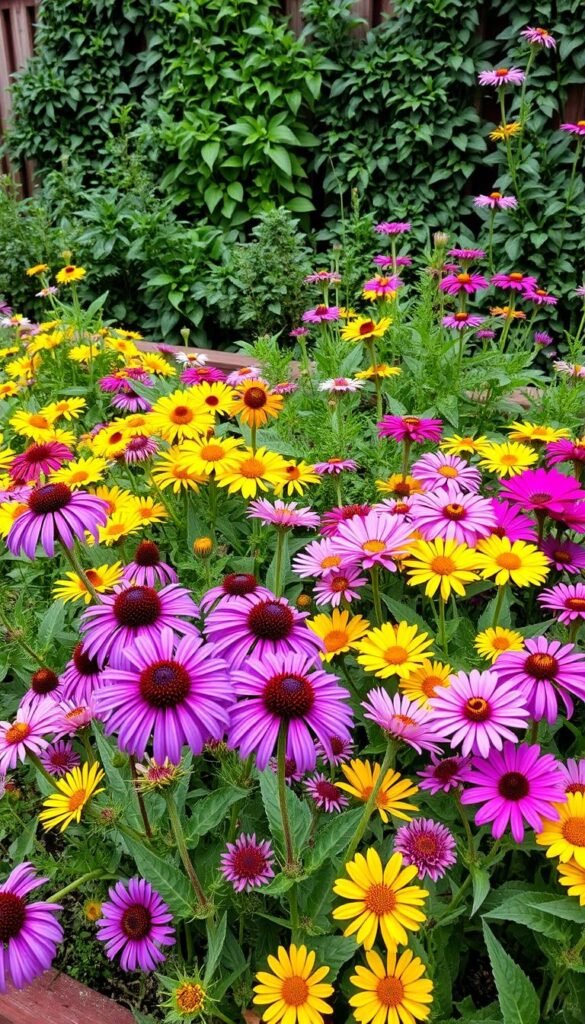
Have you ever considered how a splash of color could transform your outdoor space into a buzzing sanctuary? Elevated plots let you craft eye-catching displays while supporting local ecosystems. The secret lies in pairing beauty with purpose through smart plant selection.
Incorporating Pollinator-Friendly Flowers
Choose blooms that pull double duty. Nasturtiums dazzle with fiery hues while repelling aphids. Marigolds release soil-cleaning compounds through their roots. Zinnias offer landing pads for butterflies with their flat, open faces.
Edible varieties like calendula petals brighten salads. Scatter seeds loosely for a carefree meadow vibe—pollinators prefer relaxed arrangements over rigid rows. These helpers boost yields in nearby vegetable plots too, making them garden allies.
Harmonizing Colors and Plant Textures
Layer heights for drama. Place spiky salvias behind mounding petunias, with creeping thyme spilling over edges. Contrast velvety lamb’s ear leaves with feathery cosmos foliage.
Stagger bloom times for nonstop color. Early tulips make way for mid-summer coneflowers, followed by autumn asters. Pro tip: Group cool-toned blues and purples separately from warm reds and oranges for maximum visual impact.
Remember—your elevated plot isn’t just a display. It’s a living tapestry that feeds both the soul and local wildlife. With thoughtful pairings, you’ll create spaces where every petal serves a purpose.
Building and Filling Your Raised Beds
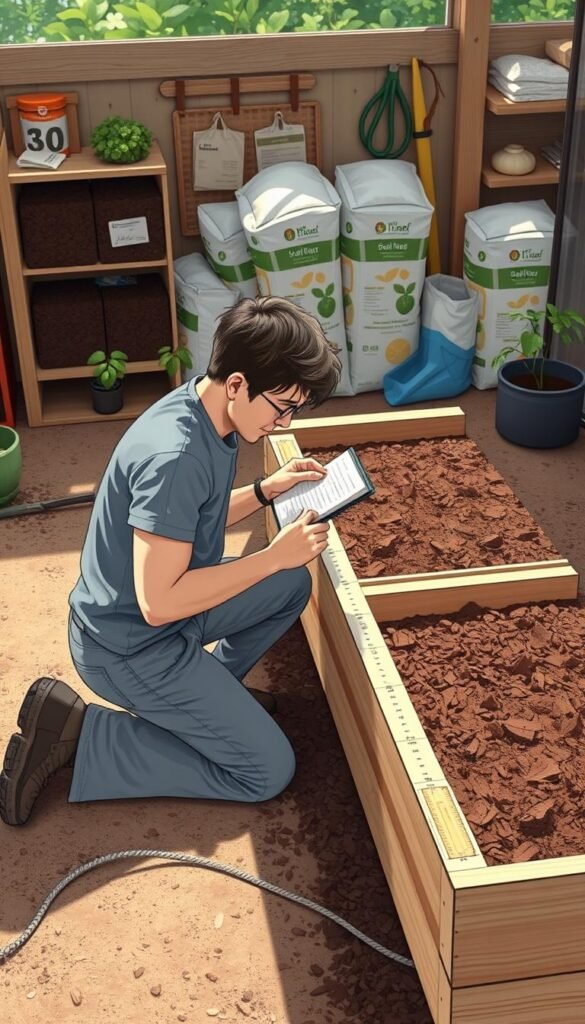
Constructing your growing space requires precise planning and smart material choices. Getting these elements right ensures your blossoms get the foundation they need to thrive.
Calculating Soil Volume and Material Requirements
Start with simple math: multiply length × width × height (in feet). Convert inches to feet by dividing by 12. A 4’×8′ bed at 8″ tall needs 4 × 8 × 0.67 = 21.44 cubic feet of soil. Always add 10% extra for settling.
Choose rot-resistant cedar or galvanized steel for frames. Heights between 8-12″ work best for most flowers. One gardener shared: “My 10-inch cedar beds lasted seven seasons without replacement!”
Custom Soil Mixes and Lasagna Gardening Techniques
Blend equal parts compost, peat moss, and vermiculite for ideal drainage. Pre-mixed options like Black Gold save time but cost more. For budget-friendly alternatives, try layering:
- Cardboard base to block weeds
- Twigs and leaves for slow-release nutrients
- Grass clippings to boost nitrogen
Water thoroughly after filling to activate decomposition. Expect to top up soil 1-2 inches each spring as organic matter breaks down. This layered approach creates richer earth than store-bought mixes over time.
Maintenance Tips for a Thriving Garden
Keeping your green space vibrant requires smart upkeep strategies. Two game-changing approaches transform routine care into powerful growth boosters—let’s explore how to maximize their impact.
Cultivating Soil Health with Crop Rotation
Rotate annuals between your elevated plots each year. This simple switch confuses pests that target specific plants and balances nutrient absorption. One grower noted: “My aphid problems vanished after moving marigolds to a new zone last spring.”
Pair rotations with seasonal compost boosts. Spread 1-2 inches of organic matter before replanting to replenish nitrogen and phosphorus. Healthy earth means stronger roots and fewer disease outbreaks.
Efficient Watering and Drip Irrigation Setup
Targeted hydration systems save time and resources. The Raised Bed Drip Kit from Johnny’s Selected Seeds delivers moisture straight to roots, cutting water use by 50% compared to sprinklers. Setup takes under an hour with these steps:
| Method | Water Savings | Setup Time |
|---|---|---|
| Hand Watering | 0% | Daily |
| Sprinklers | 20-30% | 45 mins |
| Drip Irrigation | 40-60% | 60 mins |
Automate your schedule using timers for consistent moisture. Combine this with regular maintenance routines to prevent clogs and leaks. You’ll spend weekends enjoying blooms instead of wrestling hoses.
Special Considerations for Unique Plants
How do you keep enthusiastic growers from hijacking your carefully curated space? Some species demand extra attention to prevent them from overwhelming their neighbors. Knowing which ones need containment helps maintain harmony in your growing area.
Containing Rambunctious Growers
Mint’s vigorous roots spread like wildfire, stealing nutrients from nearby herbs and flowers. One gardener confessed: “I learned the hard way—my peppermint invaded the lavender within weeks!” Keep these aromatic rebels in standalone pots to protect other plants.
Tubers like potatoes thrive in acidic earth, which most vegetables dislike. Their underground expansion also competes for space. Dedicate ground-level patches for these crops, or use separate containers with pH-adjusted soil mixes.
Large vining plants present another challenge. While cucumbers can climb trellises, squash and melons sprawl across precious real estate. Save your elevated plots for compact varieties, letting sprawling types flourish in traditional garden rows.
Smart selections make all the difference. Choose well-behaved perennials and dwarf cultivars that respect boundaries. This strategy ensures every plant gets the resources it needs without turf wars.
Seasonal Care and Extended Growing Period
Transform your growing calendar with clever timing strategies. Elevated plots unlock months of extra productivity through smart temperature management and soil preparation.
Preparing for Early Spring and Late Fall Harvests
Soil in contained plots thaws faster than ground-level earth. This thermal advantage lets you sow cool-weather varieties 3-4 weeks sooner than traditional methods. Protect tender shoots with DIY low tunnels—bend PVC pipes into hoops and drape frost cloth when nights dip below freezing.
Recycled windows become instant cold frames when placed over your growing zones. These transparent lids trap warmth while shielding plants from harsh winds. One grower reported pansies blooming through December using this method!
Refresh your earth each spring and autumn with compost tea or worm castings. This annual ritual maintains nutrient density for years of vigorous growth. Pair this with staggered planting schedules—swap spent summer annuals for frost-tolerant kale or ornamental cabbage.
New to seasonal planning? Our beginners’ checklist simplifies timing decisions. You’ll master succession planting and crop rotation while enjoying fresh blossoms long after neighbors pack up their tools.

